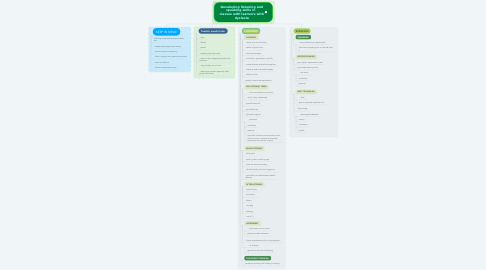
1. KEEP IN MIND!
1.1. Listening and speaking may be easier, but...
1.2. - weaker phonological processing
1.3. - narrow range of vocabulary
1.4. - lack of mastery over grammar structures
1.5. - lower confidence
1.6. - shorter concentration span
2. Teacher needs to be:
2.1. - open
2.2. - flexible
2.3. - patient
2.4. - speaking with clear voice
2.5. - aware of the competing sounds in the classroom
2.6. - using varied tone of voice
2.7. - making eye contact especially while giving instructions
3. LISTENING
3.1. PLANNING
3.1.1. - define aims of the activity
3.1.2. - define linguistic aims
3.1.3. - learning strategies
3.1.4. - motivation: applicable to real life
3.1.5. - create pleasant and safe atmosphere
3.1.6. - break up tasks into smaller stages
3.1.7. - differentiation
3.1.8. straight-forward task explanation
3.2. PRE-LISTENING TASKS
3.2.1. - clear and detailed instructions
3.2.1.1. check if they understood
3.2.2. - provide check list
3.2.3. - give head start
3.2.4. - give peer support
3.2.5. - pre-teach
3.2.5.1. vocabulary
3.2.5.2. grammar
3.2.5.3. give them a chance to manipulate, touch, mime, act out, or otherwise physically experience the relevant content
3.3. WHILE LISTENING
3.3.1. - flash cards
3.3.2. - work in pairs or small groups
3.3.3. - trace the sentence writing
3.3.4. - divide listening into short segments
3.3.5. - give choice to check answers before showing
3.4. AFTER LISTENING
3.4.1. - avoid writing
3.4.2. - movement
3.4.3. - drama
3.4.4. - role play
3.4.5. - drawing
3.4.6. - use of L1
3.5. ASSESSMENT
3.5.1. - give ample time to revise
3.5.1.1. practice outside classroom
3.5.2. - check comprehension first in pairs/groups
3.5.3. - no dictation
3.5.3.1. gap test can be too challenging
3.6. THE BIGGEST PROBLEM:
3.6.1. combining listening with reading or writing
4. SPEAKING
4.1. REMEMBER!
4.1.1. many students have special gifts
4.1.1.1. give them a speaking role to use and show it
4.2. BEFORE SPEAKING
4.2.1. - give explicit explanation of task
4.2.2. - give ample planning time
4.2.3. - pre-teach
4.2.3.1. vocabulary
4.2.3.2. grammar
4.3. BEST TECHNIQUES
4.3.1. - drills
4.3.1.1. give an easy and repetitive role
4.3.2. - memorizing
4.3.3. - drama games because
4.3.3.1. motion
4.3.3.2. movement
4.3.3.3. moods
